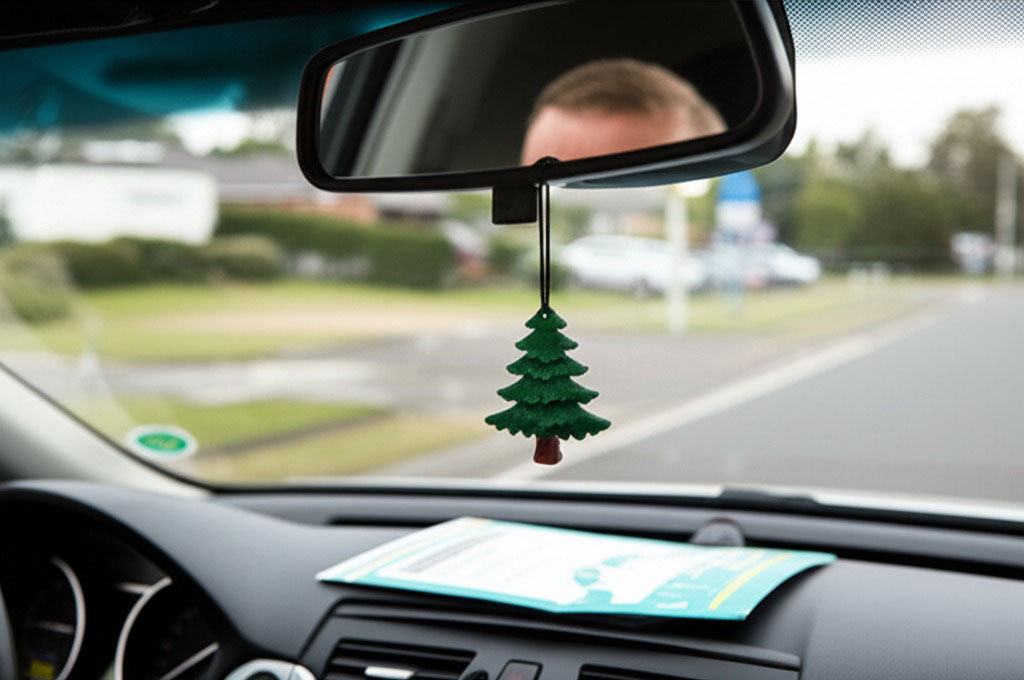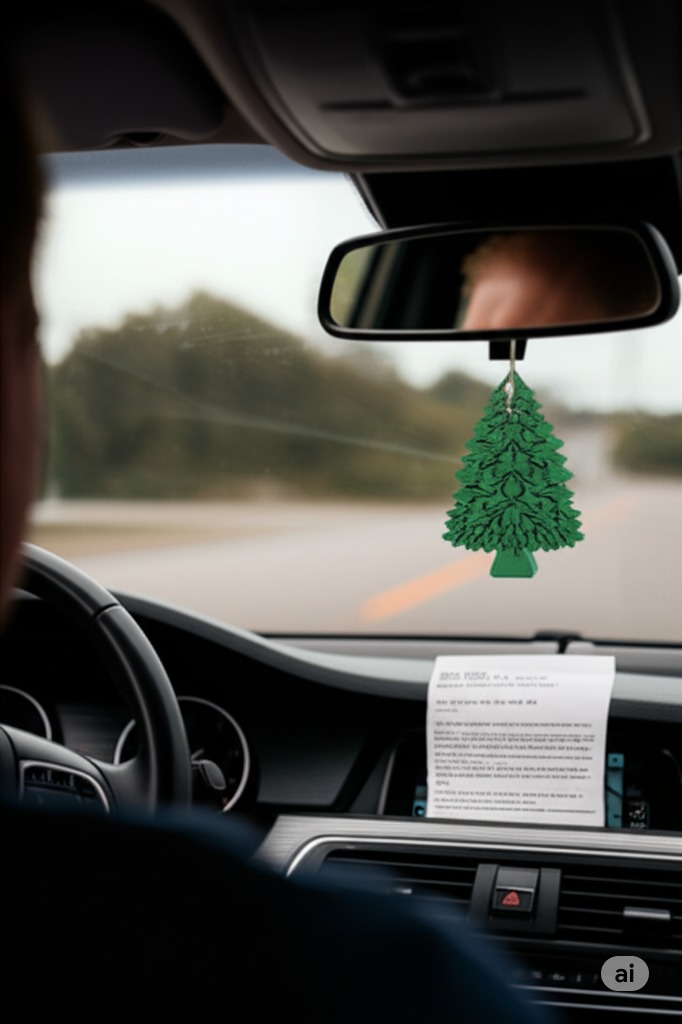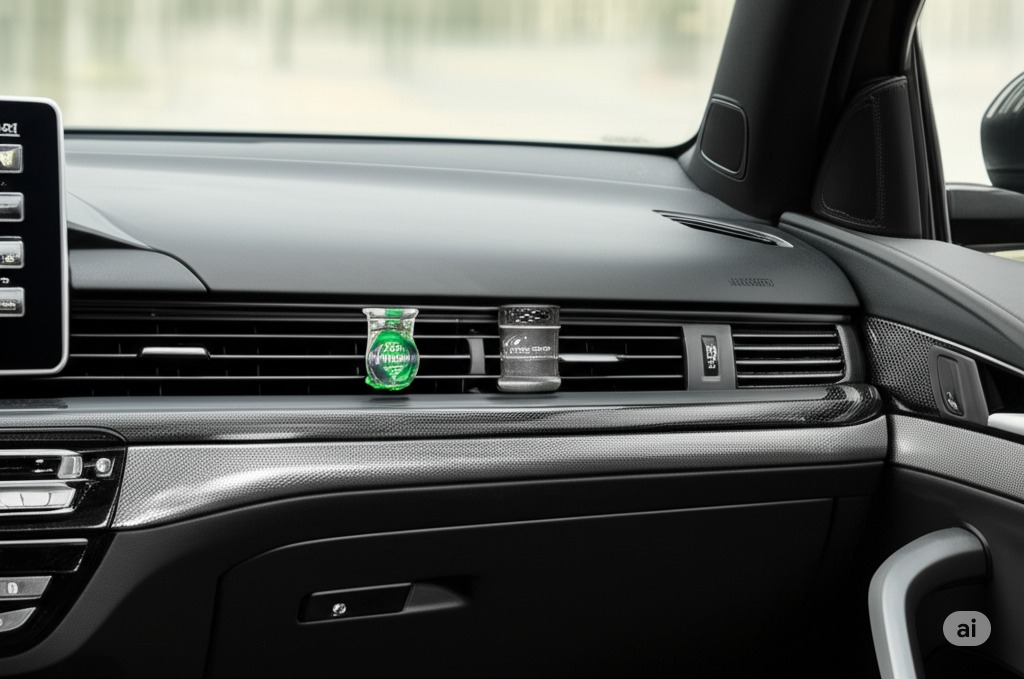Can You Hang an Air Freshener in Your Car?
Table of Contents
Part 1 - Is It Illegal to Hang an Air Freshener?
Part 2 - What Counts as Obstructing the Driver’s View?
Part 3 - How Much Can You Be Fined?
Part 4 - Air Freshener Types and Visibility Risk
Part 5 - Best Places to Hang Air Fresheners
Part 6 - Non-Hanging Freshener Options
can you hang an air freshener in your car? Turns out, that tiny scent booster might cost you more than you bargained for. Aussie road rules say anything that blocks your view can cop you a fine, and yep, that includes fresheners.

As NSW Road Safety puts it, “There’s no rule against fresheners—but there is a rule against obstructing your vision.” So if that coconut-scented tree is flapping in front of your windscreen, it could land you with a penalty instead of a pleasant drive.
In this guide, we’ll break down the legal grey areas, show you where it’s safe to hang your freshener, explore smarter scenting options, and help you steer clear of fines—while still keeping your car smelling ace.
Is It Illegal to Hang an Air Freshener?
Many Aussie drivers reckon hanging a little pine tree from the mirror is harmless. But the law's not always that laid-back.
1. Legal wording in Australian road rules
The Australian Road Rules don’t single out air fresheners—but they do stress that nothing should obstruct a driver’s view. The relevant traffic laws fall under sections governing "driver visibility" and compliance with national standards.
Key takeaways:
It’s not about the freshener, it’s about obstruction.
Statutory interpretation means a cop’s judgment on visibility carries weight.
Items breaching this rule may attract driving offences or fines under road safety acts.

2. State-by-state interpretation of obstruction
States interpret "obstruction" differently, and local enforcement variations matter more than you might think. Here’s a quick glance:
| State/Territory | Legal View on Obstruction | Penalty Range (AUD) |
|---|---|---|
| NSW | Objects can’t impair vision | $116 – $352 |
| VIC | Police discretion applies | $192+ |
| QLD | Interpreted under safety laws | $100 – $287 |
📌 Note: Police discretion and local council ordinances often determine how harshly laws are enforced, especially in school zones or busy intersections.
3. Common driver misconceptions about legality
Mate, there are a few classic driving myths that trip people up:
“It’s legal if it’s small.” → Not true. Even a small freshener can count as an obstruction.
“Everyone does it, so it’s fine.” → Wrong again. Popular doesn’t mean legal.
“You only get fined if it causes a crash.” → Nope. Traffic fines can apply even at a red light.
🚗 One Sydney driver shared: “I thought it was just a warning thing. Next thing you know, I’m $250 out and no air freshener.”
🗣️ Road Safety Expert James Arnold notes, “People confuse convenience with legality. But the rulebook is clear—vision comes first.”
What Counts as Obstructing the Driver’s View?
Many Aussies hang bits and bobs in their car without a second thought—but what actually counts as blocking your vision? Here’s how the rules break it down.
1. Definition of “driver’s clear vision”
Your driver’s clear vision refers to an unobstructed view through the windscreen and mirrors, essential for safe driving. According to road safety regulations, anything in your line of sight that could impair visibility—like air fresheners, stickers, or devices—can be deemed illegal. The key term here is “obstruction,” meaning even small items may compromise your field of view and increase crash risk.
Authorities define impaired vision as any blockage that interferes with the ability to spot pedestrians, road signs, or oncoming traffic.
2. Objects most often flagged by police
When it comes to traffic stops, police often call out these visibility offenders:
Hanging air fresheners (especially those swinging from the mirror)
GPS units placed too high on the windshield
Dash cams or phone mounts in direct sightlines
Fuzzy dice or decorations
Sticky-note reminders or toll receipts
“It might feel harmless,” says Senior Constable Dani Harris, “but if it’s dangling in your eyeline, it’s a hazard—not a decoration.”
3. Impact of object size and shape
Size really does matter—especially when it’s hanging in front of your windscreen.
Large flat items like cardboard signs block wider angles and create bigger blind spots.
Bulky or oddly shaped objects (e.g. plush toys) increase the risk of visual distraction.
Even small swinging items catch the eye constantly, pulling your attention from the road.
So even a little object can cause a big drama. The shape and motion can be just as risky as the size.
4. Rear-view mirror and legal grey zones
Here’s the sticky bit: the rearview mirror is technically a legal mounting spot in most states—but that doesn’t mean you can hang anything you like off it.
Many state traffic laws don’t spell out “air fresheners,” but use vague language like "driver’s view must remain unobstructed." This creates grey zones that vary by officer or state.
If you're modifying your mirror or adding decorations, you're flirting with legal ambiguity. Best bet? Keep it minimal or move it elsewhere.
How Much Can You Be Fined?
“Mate, I only had one of those little tree fresheners hangin’ from the mirror,” said Jamie, a P-plater from Melbourne. “Next thing I know, I’m hit with a $120 fine. The cop reckoned it was blocking my view.”
In most Australian states, fines for obstructed view violations start at $116 and can reach up to $410, depending on the circumstances and whether the matter ends up in court. NSW, QLD, and WA have cited drivers under Regulation 297(1) of the Australian Road Rules: a vehicle must not be driven with a view obstructed by anything hanging, even if it seems minor. Law enforcement officers have full discretion to issue an infraction notice if they determine that an object interferes with driving safety.
🚨 Key legal risks include:
Fine amount: Between $116 and $410
Penalty points: In some states, like NSW, obstructed vision can lead to 1 demerit point
Court costs: If disputed, legal costs may far exceed the original fine
Road safety expert Senior Constable Dale Waters told ABC News, “It is not about the object itself. It is about whether it interferes with your ability to react quickly and clearly on the road.”
This regulation is part of broader traffic regulations designed to limit visual distractions. While air fresheners may seem harmless, enforcement comes down to how law enforcement interprets the object’s position and impact on visibility. And drivers have little recourse once the ticket is issued.
Products with clear safety labels or those endorsed by auto safety organisations are more likely to be considered compliant. Brands that display RMS or TAC safety recognition have become more popular among cautious drivers.
Air Freshener Types and Visibility Risk
Not all car air fresheners are created equal. Some keep your ride smelling mint; others might get you fined or cause damage. Let’s break it down.
Tree-style fresheners and mirror swing
Those classic pine-scented trees are a car icon—but they’re not just dashboard decor. Their swinging motion can block your rearview mirror, especially on bumpy roads. While they’re designed for scent diffusion, they double as potential hazards if they sway too low or get in the driver’s line of sight. Keep them small, and tuck them high if you insist.
Can vent clips be distracting?
Placement matters – Clips near central vents can distract with scent bursts or flashing plastic.
Driver focus – A powerful air freshener clip aimed right at your face might mess with concentration, especially during long drives.
Dashboard visibility – Some bulky clips can block climate controls or nav screens. Go for slimline designs with lower scent intensity.
Gel pods and sunlight issues
These little buggers can smell amazing—until they don’t. Aussie sun can melt gel air fresheners like cheese on a hotplate. Result? Leaky mess, dashboard stains, and ruined plastics. Heat sensitivity and chemical composition make them less ideal for places like Perth or Darwin. Avoid placing them where direct sunlight hits for most of the day.

Dashboard-mounted scent risks
Mounting a car scent on your dash may seem clever, but it’s a gamble.
Can obstruct vision or even interfere with airbag deployment.
High temps from sunlight exposure can warp the device or cause chemical spills.
As auto detailer Kev Rawlins says, “Dash sticks and heat don’t mix. You’re risking sticky drama on a $500 dash.”
Ceiling-hung novelty fresheners
Ceiling-mounted air fresheners look quirky—tiny sneakers, mini utes, even emoji faces—but function can take a back seat. They’re tricky to install, rarely last long, and may hang awkwardly near your field of vision. Scent dispersal’s usually uneven too. They're more about style than performance, so if you're after odor control, skip the gimmicks.
Best Places to Hang Air Fresheners
Not every spot in your car is safe or legal for hanging a freshener. Let's check where it won’t get you in strife.
Mirror-safe positions for clear view
Choosing the right position on or around your mirror can keep you fresh without copping a fine.
Stick to small, non-swinging designs that sit close to the base of the mirror arm.
Avoid hanging anything that enters your direct inspection angles or disrupts visual assessment during tight turns.
In brighter conditions, reflective surfaces can amplify glare—bad news when it comes to lighting techniques at night.
Best pick? A compact freshener looped over the mirror's ergonomic positioning zone, trimmed tight for zero sway.
Low-hanging areas inside the cabin
Here’s a ripper tip: tuck those fresheners low, out of your line of sight.
Underside of the glove box – minimal disruption, strong scent diffusion near vents.
Internal frame beneath the dash – hidden crevices and interior seams are prime real estate.
Behind the centre console – base connection zones and wiring channels are both effective and invisible.
Avoid areas with dust accumulation points unless you’re ready for weekly clean-ups.
As one seasoned detailer puts it: "Scent placement should hit your nose, not your windscreen."
Non-Hanging Freshener Options
Freshening your car doesn’t have to mean hanging something in your line of sight. These low-profile options keep your ride smelling fresh without running afoul of road rules.
Under-seat scent diffusers
Tucked out of sight and away from your mirror, under-seat scent diffusers are a quiet achiever. These car air fresheners use diffuser devices and scent technology to slowly release a long-lasting aroma from beneath your seat—making them ideal for drivers who want effective odor control without clutter.
“Our under-seat units last up to 60 days without overpowering the space,” says Mia Tran, product lead at AutoScents AU.
Vent-mounted clip fresheners
These car vent clips hook straight into your vehicle’s ventilation system, releasing fragrance through airflow diffusion.
The clip-on air freshener design is simple to install and perfect for even, gentle scent delivery.
Choose from clip designs that blend in with your dash—keeping things neat while managing interior odor.
Cupholder-based aroma pods
Pop the car cupholder freshener into your console—no sticky adhesives, no swinging trees.
These aroma pods are spill-proof, compact, and stay out of your visual line.
Thanks to pod systems, they’re easy to swap and perfect for drivers who like to mix up their automotive aroma every month or so.
| Product Name | Average Lifespan (days) | Scent Strength (1–5) |
|---|---|---|
| PodScents Breeze | 45 | 3.5 |
| ClipFresh Wave | 30 | 4.0 |
| SeatMist Pro | 60 | 4.5 |
These car interior scent solutions let you cruise legally and comfortably—with no distractions and no drama.
Do Hanging Air Fresheners Work Better?
Not all air fresheners are created equal. Let’s unpack how different designs perform in scent spread, lasting power, and even under Aussie heat.
Coverage area comparison by type
When it comes to fragrance reach, the shape and placement of your air freshener make a big difference.
Hanging fresheners offer broad aroma spread, but lack coverage uniformity.
Vent clips deliver more directional scent diffusion, ideal for medium vehicle interiors.
Under-seat pods work well for small spaces but may struggle in SUVs.
Pro tip: Match your freshener type to your room size (i.e., cabin volume) for best results.
Longevity of scents over time
Some fresheners vanish faster than your morning coffee. Here’s why:
Evaporation rate: Hanging types dry up quicker due to direct airflow.
Air freshener lifespan: Gel-based products and pods can last weeks longer thanks to time release tech.
Scent intensity fade: Lighter fragrances degrade faster than musky or woodsy blends.
💬 “Choose products with controlled-release membranes for more stable scent,” says Sara Coombs, scent chemist at CleanRide Labs.
Best scent dispersal for small cars
If you’ve got a compact car, you don’t need a scent bomb—just good placement.
Clip-on diffusers use the ventilation system to circulate fragrance evenly.
A vent clip near the driver's side boosts scent distribution without overpowering passengers.
Car diffusers with essential oils can be overkill in tight cabin sizes, so use sparingly.
Keep it low-key. You want clean, not cologne-punched.
Climate’s effect on scent strength
Environmental factors affect scent performance more than you'd think.
High temperature = quicker evaporation rate, shorter lifespan.
Humidity can actually mute scent intensity by slowing fragrance volatility.
In dry inland regions, scents disperse faster but fade fast too.
Coastal climate conditions may stabilise aroma, but not as punchy on start-up.
| Climate Type | Avg Temp (°C) | Scent Lifespan (days) |
|---|---|---|
| Tropical (QLD) | 30 | 10–12 |
| Arid (NT) | 38 | 5–7 |
| Coastal (NSW) | 25 | 14–16 |
Test your scent in real driving conditions, not just on the shelf.
Top-Selling Legal Air Fresheners
When it comes to driving comfort, Australians are surprisingly picky about scent. A clean-smelling cabin is more than just a perk — it is part of the experience. Leading sellers like Little Trees, Febreze Car, and Chemical Guys continue to dominate shelves not only because they smell good, but because they play by the rules.
Dr. Karen Wells, an environmental chemist and advisor to the Australian Automotive Standards Panel, noted during a recent interview, “Low-profile designs like vent clips and gel fresheners have passed visibility safety reviews in multiple states.” This feedback reflects growing consumer preference for compliance without compromise.

Drivers are opting for these top choices:
Febreze Car Vent Clips – Compact, non-obstructive, tested for glare resistance
Chemical Guys Odor Eliminator Spray – Popular for “New Car Scent”, endorsed by detailers nationwide
Little Trees Gel Fresheners – Dashboard-safe and praised for lasting up to 30 days
Ozium Air Sanitizer Spray – Backed by medical facilities for air purification efficiency
Australian consumers often cite a “fresh but not fake” scent profile as key to repeat purchases. On forums like Whirlpool and ProductReview.com.au, reviews mention gel types holding up better during hot summers, while sprays like Ozium offer quick refresh without residue.
Products like Febreze Car have won Good Design Awards for their safety-conscious clips. When choosing a legal freshener, it is less about gimmicks and more about thoughtful, road-safe design.
So, can you hang an air freshener in your car? Technically, yeah—but only if it’s not blocking your view. Think of it like tossing a hat on your dashboard: harmless till it slides and snags your sightline at the worst time.
“Obstruction’s obstruction,” a VicRoads rep once said. “Doesn’t matter if it smells like vanilla or V8.”
They’re not outright illegal, but they can be if they block your view. Most states don’t ban fresheners directly, but if a police officer thinks it’s an obstruction, you could be fined. It’s all about placement, size, and visibility.
In legal terms, it means anything that interferes with your clear view of the road—through the front, sides, or rear of the vehicle. Even a swinging tree-shaped freshener can be considered an issue if it’s in your line of sight while driving.
Yep, you can. In NSW, the fine for driving with a visual obstruction can go over $300, and you might even get demerit points. It depends on the officer’s judgment at the time, so it’s best not to take chances.
Avoid anything dangling from the mirror—especially in smaller cars where space is tighter.
Vent-mounted fresheners (out of eye level)
Under-seat scent pods or pouches
Cupholder-based diffusers
Rear passenger area, hanging lower
Not always, but it happens. Most drivers get pinged during random stops or if they’re pulled over for another reason. If the officer spots something blocking your view, they might throw in that fine too.
These do the job without drawing attention.
Vent clips, since they sit low and stay still
Under-seat fresheners, which don’t affect visibility at all
Gel cans or pods, tucked in cupholders or centre consoles
They can be. At night, street lights, headlights, or dashboard reflections can catch on shiny or swinging objects, making them distracting—especially if they sway. Even a small item can feel much more noticeable in low light.
There’s no one-size-fits-all, but Aussie drivers love:
The key is scent + safety balance.
Little Trees vent clips – compact, simple
Air Spencer gel pods – strong but subtle
Meguiar’s Whole Car Air Refresher – for a full freshen-up
Technically, yes—but again, it’s the size, movement, and placement that matter. A small charm might be fine. But a big fluffy dice? That’s asking for trouble. Use common sense—if it moves around or blocks part of your view, ditch it.

Leave a comment